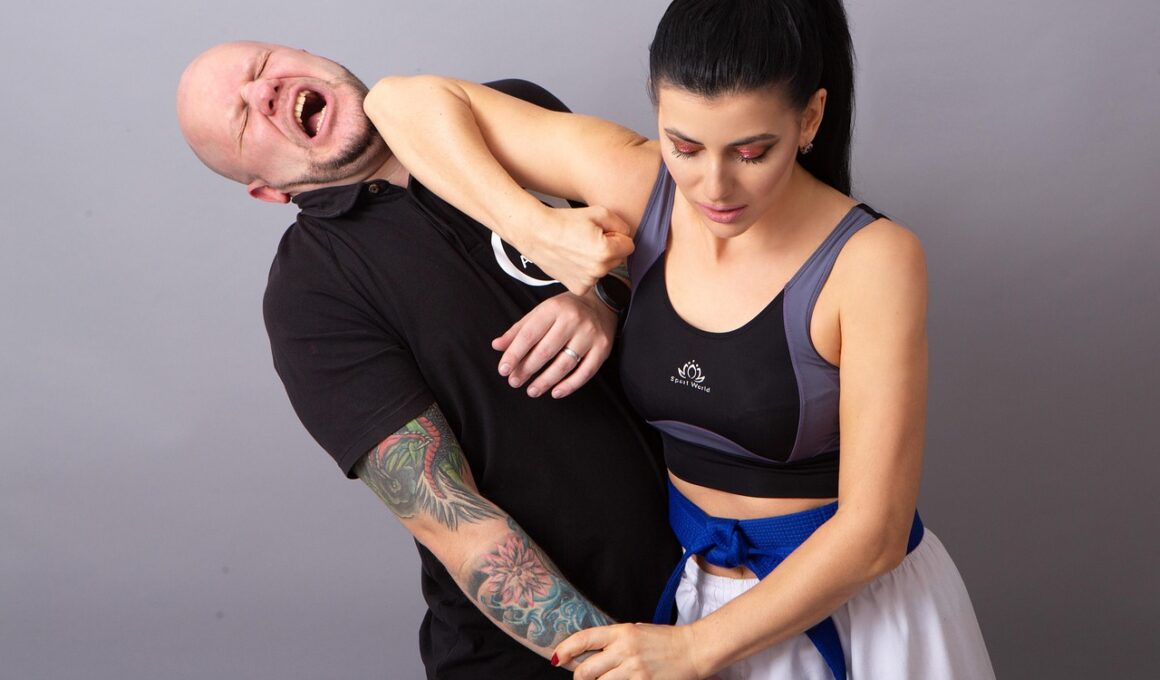Defensive Stances for Women: Building Confidence and Security
In today’s world, self-defense is an essential skill that every woman should have. Understanding the various defensive stances can significantly enhance one’s confidence during potential confrontations. A proper stance not only helps in maintaining balance but also prepares the body for any physical moves needed. Body posture, weight distribution, and hand placement all play vital roles in how effective the stance will be. By taking a stable and assertive position, women can better communicate their readiness to defend themselves. Being aware of one’s surroundings is equally important as it aids in recognizing potential threats early. Defensive stances should be practiced regularly to ensure muscle memory kicks in during real situations. Training sessions that focus on various stances offer women the opportunity to learn and adapt these techniques effectively. Such practice leads to increased confidence in handling aggressive scenarios. Therefore, investing time in self-defense training is paramount to ensuring safety. Women should seek out classes that teach practical stances and movements that cater to individual comfort levels. This training can play a crucial role in personal empowerment and security, which is vital in today’s society.
Understanding the Importance of Defensive Stances
Defensive stances provide women with a foundation for self-defense techniques. An effective stance creates a strong base, making it more difficult for an opponent to knock a person off balance. The first key element to a solid defensive stance is positioning. Place your feet shoulder-width apart to maintain balance while also being relaxed enough to move quickly if needed. Next, bend your knees slightly, allowing the body to be more agile when reacting to threats. Keeping the hands up near the face not only protects important areas but also prepares for striking if necessary. Utilizing elbow protection by bringing arms close to the body can guard against potential attacks. Women should practice maintaining a slight lean forward in their stance, promoting an outward, confident presence. This posture can dissuade potential aggressors from approaching. Practicing various movements while in the stance allows for a smoother transition to offensive actions if they become necessary. Self-defense courses focusing on these core principles can greatly benefit women by ingraining these concepts through repetition. Through disciplined practice and understanding, every woman has the power to defend herself with confidence and effectiveness.
For optimal self-defense readiness, women must learn about versatile stances they can adapt in various situations. One popular stance is the **ready stance**, wherein the feet are positioned shoulder-width apart, arms up, and hands prepared for defense. This position allows quick movement in any direction while keeping the upper body protected against attacks. Meanwhile, the **archer stance** promotes mobility and protection, where one foot is stepped back allowing for rapid response with the body still positioned defensively. The **side stance** makes one a smaller target, allowing protection of vital areas from side attacks. Engaging in drills using these stances can enhance one’s ability to anticipate threats and react swiftly. Additionally, envisioning real-life scenarios during practice enables women to mentally prepare for potential dangers. Regular training can help decrease anxiety levels, allowing a more competent approach to self-defense. Understanding the various contexts in which each stance is effective further empowers women to stay safe. Women should always remain conscious of how they carry themselves in public, projecting confidence through their stance and body language. Recognizing these practical applications and practicing regularly will help solidify these essential defense skills.
Pairing defensive stances with practical techniques can greatly improve women’s self-defense capabilities. Techniques such as striking, blocking, and grappling can be easily integrated into the chosen stances. Learning which strikes are most effective from specific stances enhances overall reaction time during confrontations. For example, a quick punch can be delivered effectively from a ready stance, while a kick may be executed from the side stance. Incorporating defensive maneuvers such as deflecting an opponent’s attack while maintaining a stance creates better defensive responses. Moreover, practicing these combinations can solidify reaction speed and enhance self-confidence. Many self-defense classes incorporate scenario-based training, allowing participants to practice these movements under simulated stress. By learning to implement stances with techniques, women can develop their unique strategies for personal protection. Each woman must find the styles and approaches that resonate with her strengths. Furthermore, understanding that one can defend themselves does not require extensive training bolsters confidence even more. In stressful situations, having a clear action plan based on practiced stances and techniques can significantly improve the chances of successfully protecting oneself if confronted.
Empowerment Through Knowledge and Practice
Empowerment through knowledge and practice is critical in self-defense training. Each woman has the ability to learn and adopt effective techniques that work for her. Classes generally teach essential skills and the principles of maintaining a defensive stance, which fosters an understanding of situational awareness. Women should familiarize themselves with the common types of aggression or attacks they might face, further promoting self-defense readiness. This knowledge can also include understanding how attackers typically behave or react. Engaging in regular practice helps reinforce these skills, making them second nature. Women become more adept at reading environmental cues and recognizing threats through scenarios discussed in training. By incorporating these concepts into their outdoor routines, they cultivate mindfulness which is essential for self-protection. Practicing stances, movements, and combinations develops self-confidence, not only in one’s physical capabilities but also in decision-making skills. Connecting with fellow participants during training builds camaraderie, enhancing motivation and accountability. Women uplift each other’s confidence frequently in supportive self-defense settings that promote empowerment. The driving force of self-defense ultimately comes down to knowledge, practice, and the unwavering belief in one’s ability to defend oneself effectively.
Regular practice and commitment to self-defense skills enable women to internalize defensive stances. Participating in structured training environments such as martial arts or self-defense courses under experienced instructors can lead to continual improvement. Instructors encourage participants to engage in consistent drills that progressively enhance skills over time. Engaging in fitness routines that promote strength and flexibility will also improve overall self-defense capabilities. Alternate activities such as yoga or pilates can significantly enhance core stability and balance, which are vital in maintaining a strong defensive stance. Focus on core strength allows for greater agility and control during confrontations. Practicing alone or with partners, women can replicate potential danger scenarios, thus mentally preparing themselves. Setting personal goals in self-defense training can further fuel motivation and progress toward achieving set objectives. Instructors may also provide feedback, allowing participants to adjust their stances and movements accordingly. The combination of dedication, tailored feedback, and ongoing practice creates a robust self-defense skill set that empowers women. Ultimately, with the knowledge they gain, women not only learn to defend themselves but also develop a sense of security in any environment.
Conclusion: Cultivating a Confident Mindset
In conclusion, cultivating a confident mindset through self-defense training is paramount for every woman. Engaging in reinforced defensive stances, techniques, and strategies encourages women to think critically in potentially harmful situations. The knowledge they gain empowers them to act decisively, ensuring their safety. Moreover, understanding one’s environment fosters instinctual awareness, allowing for timely reactions to threats. Women are reminded regularly that confidence is not just about physical prowess but also about mental preparedness. This shift in mindset ensures that women are not just reactively defending themselves, but proactively creating their safety. Through disciplined training and community support, they can build lasting confidence and security while forging strong connections with fellow practitioners. Furthermore, encouraging women to take charge of their own safety instills a broader message of empowerment in society. In time, this knowledge can lead not only to individual safety but also a collective movement toward greater awareness. The importance of defensive stances in building confidence cannot be overstated. Ultimately, confidence cultivated through effective training ensures women can confidently navigate an ever-changing world. By making self-defense a priority, women equip themselves for challenges both on and off the mat.
As a final note, investing in one’s self-defense knowledge and skills is a lifelong journey. Each training session offers invaluable lessons that improve not only physical abilities but also mental resilience. Women can benefit significantly from consistent practice combined with awareness of safety protocols. Many women find self-defense training a transformative experience, impacting their everyday confidence levels positively. The reach of self-defense extends beyond physical techniques to influencing mental states that enhance overall well-being. By embracing this discipline, women foster a proactive mindset that encourages them to navigate life’s challenges with confidence. Adapting defensive stances to specific environments and situations empowers women to feel secure and prepared. They learn to trust their instincts, further enhancing their capacity to respond to unforeseen events. Understanding the efficacy of defensive stances plays a crucial role in women’s overall safety. What begins as a means of protection will ultimately evolve into a holistic approach to self-sufficiency. Women should embrace the self-defense journey proactively, continually seeking knowledge, and celebrating their progress. In doing so, they will inevitably foster a protective mindset that positively affects all aspects of their lives.


